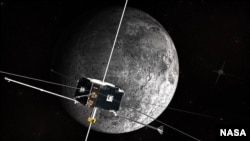The United States is renewing and bolstering its commitment to long-term, sustainable space exploration, with plans to land the next man and first woman on the moon by 2024. Scott Pace is Executive Secretary of the National Space Council. He explained how the new program, called Artemis, is the “first step” in a robust commitment to expanded space exploration:
“We first need to learn how to drive around the block before we can drive cross-country. And so while Mars is the horizon goal and the goal that we are building toward, we are first looking to demonstrate that we can operate on the moon again.”
An early goal, said Executive Secretary Pace, is to get back to “launching American astronauts from American rockets on American soil.” Test flights to the International Space Station, operated with private sector partners, could start in the first part of 2020:
“After that, the next big milestone is we want to demonstrate the space launch system, which is a large, heavy lift booster. … It's really a rather gigantic rocket to carry us back to the moon, and we're hoping to have that demonstrate itself in 2021. And then we're looking at sending an unmanned mission around the Earth to demonstrate all the parts and components of the lunar return. And then we're going to send humans around the moon. And then we're going to land on the moon. And that's our immediate goal through 2024.”
The plan is geared toward building a sustainable presence on the moon:
“We’re looking at reusable lunar landers that we can refuel, for going back and forth. We're looking at exploring for water ice on the south pole of the moon that can be broken down into hydrogen and oxygen that can be used to create fuel for those landers … really establishing a permanent facility there that will train us for operations in deep space.”
“With Apollo in the history books, the Artemis mission has begun,” said Vice President Mike Pence. “We are well on our way to making NASA’s Moon-to-Mars Mission a reality.”














